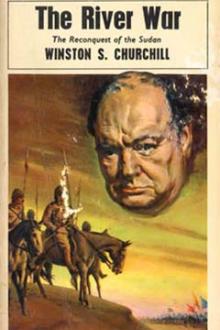The River War - Winston Churchill (books under 200 pages .txt) 📗

- Author: Winston Churchill
- Performer: -
Book online «The River War - Winston Churchill (books under 200 pages .txt) 📗». Author Winston Churchill
The event was foreshadowed. On the 5th of December the Egyptian Council of Ministers, presided over by the Khedive in person, decided on their own initiative to despatch an official letter expressing in warm terms their gratitude for the financial help offered them by her Majesty’s Government.
‘I am desired,’ said Boutros Pasha, ‘to beg your lordship to be good enough to convey to his lordship the Marquess of Salisbury the expression of the lively gratitude of the Khedive and the Egyptian Government for the great kindness which her Majesty’s Government has shown to them on this occasion.’ [EGYPT, No. 1, 1897.]
On the 6th of December �E500,000, together with �E15,600 interest and costs, in gold, was conveyed in boxes in a cart from the Egyptian Treasury to the offices of the Caisse de la Dette. The effect was tremendous. All Cairo knew of the difficulty. All Cairo witnessed the manner in which it had been overcome. The lesson was too plain to be lost on the native mind. The reverse of the French diplomacy was far greater even than its success had appeared. For many years French influence in Egypt had not received so heavy a blow; yet even in the short space of time which this story covers it was to receive a still more terrible wound.
CHAPTER V: THE BEGINNING OF THE WAR
Shortly before midnight on the 12th of March, 1896, the Sirdar received instructions from Lord Cromer authorising an expedition into the Dongola province and directing him to occupy Akasha. The next morning the news was published in the Times, ostensibly as coming from its correspondent in Cairo: and the Egyptian Cabinet was convened to give a formal assent by voting the decree. On the 14th the reserves were called out. On the 15th the Khedive reviewed the Cairo garrison; and at the termination of the parade Sir H. Kitchener informed him that the earliest battalions would start for the front that night.
The Egyptian frontier force had always been kept in a condition of immediate readiness by the restless activity of the enemy. The beginning of the long-expected advance was hailed with delight by the British officers sweltering at Wady Halfa and Sarras. On Sunday, the 15th of March, three days after the Sirdar had received his orders, and before the first reinforcements had started from Cairo, Colonel Hunter, who commanded on the frontier, formed a small column of all arms to seize and hold Akasha. At dawn on the 18th the column started, and the actual invasion of the territory which for ten years had been abandoned to the Dervishes began. The route lay through a wild and rocky country—the debatable ground, desolated by years of war—and the troops straggled into a long procession, and had several times for more than an hour to move in single file over passes and through narrow defiles strewn with the innumerable boulders from which the ‘Belly of Stones’ has derived its name.
The right of their line of march was protected by the Nile, and although it was occasionally necessary to leave the bank, to avoid difficult ground, the column camped each night by the river. The cavalry and the Camel Corps searched the country to the south and east; for it was expected that the Dervishes would resist the advance. Creeping along the bank, and prepared at a moment’s notice to stand at bay at the water’s edge, the small force proceeded on its way. Wady Atira was reached on the 18th, Tanjore on the 19th, and on the 20th the column marched into Akasha.
The huts of the mud village were crumbling back into the desert sand.
The old British fort and a number of storehouses—relics of the Gordon Relief Expedition—were in ruins. The railway from Sarras had been pulled to pieces. Most of the sleepers had disappeared, but the rails lay scattered along the track. All was deserted: yet one grim object proclaimed the Dervish occupation. Beyond the old station and near the river a single rail had been fixed nearly upright in the ground. From one of the holes for the fishplate bolts there dangled a rotten cord, and on the sand beneath this improvised yet apparently effective gallows lay a human skull and bones, quite white and beautifully polished by the action of sun and wind. Half-a-dozen friendly Arabs, who had taken refuge on the island below the cataract, were the only inhabitants of the district.
The troops began to place themselves in a defensive position without delay.
On the 22nd the cavalry and Camel Corps returned with the empty convoy to Sarras to escort to the front a second and larger column, under the command of Major MacDonald, and consisting of the XIth and XIIth Soudanese, one company of the 3rd Egyptians (dropped as a garrison at Ambigole Wells), and a heavy convoy of stores numbering six hundred camels. Starting from Sarras on the 24th, the column, after four days’ marching, arrived without accident or attack, and MacDonald assumed command of the whole advanced force.
Akasha was now converted into a strong entrenched camp, in which an advanced base was formed. Its garrison of three battalions, a battery, and the mounted troops, drew their supplies by camel transport from Sarras.
The country to the south and east was continually patrolled, to guard against a turning movement, and the communications were further strengthened by the establishment of fortified posts at Semna, Wady Atira, and Tanjore. The friendly Arab tribes—Bedouin, Kabbabish, and Foggara—ranged still more widely in the deserts and occupied the scattered wells. All this time the Dervishes watched supinely from their position at Fuket, and although they were within a single march of Akasha they remained inactive and made no attempt to disturb the operations.
Meanwhile the concentration of the Egyptian army on the frontier was proceeding. The reservists obeyed the summons to the colours of their own free will and with gratifying promptness, instead of being tardily dragged from their homes in chains as in the days of Ismail. All the battalions of the army were brought up to war strength. Two new battalions of reservists were formed, the 15th and 16th. The 15th was placed at Assuan and Korosko on the line of communications. The 16th was despatched to Suakin to release the two battalions in garrison there for service on the Nile. The 1st Battalion of the North Staffordshire Regiment was moved up the river from Cairo to take the place of the Wady Halfa garrison of six battalions, which had moved on to Sarras and Akasha. A Maxim battery of four guns was formed from the machine-gun sections of the Staffordshires and Connaught Rangers and hurried south. The 2nd, 4th, 5th, and 6th Egyptian Battalions from Cairo were passed in a continual succession along the railway and river to the front. In all this busy and complicated movement of troops the Egyptian War Office worked smoothly, and clearly showed the ability with which it was organised.
The line of communications from Cairo, the permanent base, to the advanced post at Akasha was 825 miles in length. But of this distance only the section lying south of Assuan could be considered as within the theatre of war. The ordinary broad-gauge railway ran from Cairo to Balliana, where a river base was established. From Balliana to Assuan reinforcements and supplies were forwarded by Messrs. Cook’s fleet of steamers, by barges towed by small tugs, and by a number of native sailing craft. A stretch of seven miles of railway avoids the First Cataract, and joins Assuan and Shellal. Above Shellal a second flotilla of gunboats, steamers, barges, and Nile boats was collected to ply between Shellal and Halfa. The military railway ran from Halfa to Sarras. South of Sarras supplies were forwarded by camels. To meet the increased demands of transport, 4,500 camels were purchased in Egypt and forwarded in boats to Assuan, whence they marched via Korosko to the front. The British Government had authorised the construction of the military railway to Akasha, and a special railway battalion was collected at Assuan, through which place sleepers and other material at once began to pass to Sarras. The strategic railway construction will, however, form the subject of a later chapter, which I shall not anticipate.
By the 1st of April, less than three weeks from the commencement of the advance, the whole line of communications had been organised and was working efficiently, although still crowded with the concentrating troops.
As soon as the 16th Battalion of reservists arrived at Suakin, the IXth Soudanese were conveyed by transports to Kossier, and marched thence across the desert to Kena. The distance was 120 miles, and the fact that in spite of two heavy thunderstorms—rare phenomena in Egypt—it was covered in four days is a notable example of the marching powers of the black soldiers. It had been determined that the Xth Soudanese should follow at once, but circumstances occurred which detained them on the Red Sea littoral and must draw the attention of the reader thither.
The aspect and history of the town and port of Suakin might afford a useful instance to a cynical politician. Most of the houses stand on a small barren island which is connected with the mainland by a narrow causeway. At a distance the tall buildings of white coral, often five storeys high, present an imposing appearance, and the prominent chimneys of the condensing machinery—for there is scarcely any fresh water—seem to suggest manufacturing activity. But a nearer view reveals the melancholy squalor of the scene. A large part of the town is deserted.
The narrow streets wind among tumbled-down and neglected houses.
The quaintly carved projecting windows of the facades are boarded up.
The soil exhales an odour of stagnation and decay. The atmosphere is rank with memories of waste and failure. The scenes that meet the eye intensify these impressions. The traveller who lands on Quarantine Island is first confronted with the debris of the projected Suakin-Berber Railway. Two or three locomotives that have neither felt the pressure of steam nor tasted oil for a decade lie rusting in the ruined workshops. Huge piles of railway material rot, unguarded and neglected, on the shore. Rolling stock of all kinds—carriages, trucks, vans, and ballast waggons—are strewn or heaped near the sheds. The Christian cemetery alone shows a decided progress, and the long lines of white crosses which mark the graves of British soldiers and sailors who lost their lives in action or by disease during the various campaigns, no less than the large and newly enclosed areas to meet future demands, increase the depression of the visitor.
The numerous graves of Greek traders—a study of whose epitaphs may conveniently refresh a classical education—protest that the climate of the island is pestilential. The high loopholed walls declare that the desolate scrub of the mainland is inhabited only by fierce and valiant savages who love their liberty.
For eleven years all trade had been practically stopped, and the only merchants remaining were those who carried on an illicit traffic with the Arabs or, with Eastern apathy, were content to wait for better days.
Being utterly unproductive, Suakin had been wisely starved by the Egyptian Government, and the gloom of the situation was matched by the poverty of its inhabitants.
The island on which the town stands is joined to the mainland by a causeway, at the further end of which is an arched gateway of curious design called ‘the Gate of the





Comments (0)